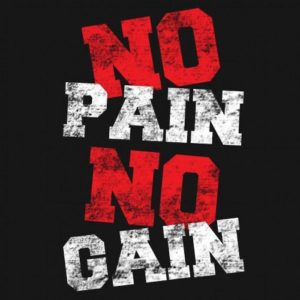No Pain No Gain
Prospective clients often ask me if my philosophy when designing workout programs is “no pain no gain.” They go on to explain that other trainers they worked with in the past seemed to revel in it, trying to create the most grueling workouts to make them suffer.
I explain that all certified personal trainers are faced with the question of how hard to push our clients, but our methodologies may differ. We should consider their medical histories, their physical histories, their personalities, what’s currently going on in their work and home lives, and what motivates them to do better. Then we ask ourselves if they are giving their all or if they are conserving energy for later. If it’s the latter, we try to determine why.
However, occasionally with some clients, it’s just the opposite. We often find it necessary to ask them to pull back a little before they injure themselves. We try to explain that the “NO PAIN, NO GAIN” mantra is very misleading, as we begin describing the differences between pain and soreness.
Pain is defined as the physical feeling caused by disease, injury, or something that hurts the body. It can be temporary such as dropping something on your foot, or longer-lasting like a bruise healing. Acute pain is sudden and sharp, while chronic is persistent and lingers. Chronic pain can continue for weeks or even years after the injury has healed. With pain, depending on its severity, our client may be able to continue exercising with modifications or return to exercise relatively quickly.
Discomfort is more difficult to describe, although most of our clients have experienced it. It falls somewhere between “normal” and pain. It’s more of a nuisance or even an ache. Sometimes after recovering from surgery, a patient will report having discomfort in that area; although it isn’t preventing functioning or even exercising and isn’t actually painful. Usually only a slight routine modification is needed, if at all, after a proper warm up.
A cramp is a painful, involuntary contraction of a muscle or muscles, typically caused by fatigue, strain, or overexertion. It comes on quick, and often prevents our client from completing the movement or action. Stretching or massaging the muscle often helps it to relax and release. If the cramp is caused by fluid loss which could be the case with a client, fluid and electrolyte replacement is needed. With a short rest period, most clients can return to the workout or a modified version of it. If this isn’t the case, a hot soak or heating pad could be used.
Then there is feeling stiff. Stiff is when it is difficult to bend or move. Many times in the morning people are stiff until they’ve had a few minutes to walk around. Many clients understand this, as they think back to a day after an intense workout. Once a client has warmed up and stretched, the workout may only need to be altered minimally.
Soreness can cause pain or distress. There is a spectrum of sore, some of which can be explained by feeling sore when you move, sore to the touch, and/or sore when you repeat the motions that originally caused the soreness. Depending on the severity, a workout may need to be greatly modified. To help lessen soreness, you can mix this in water and sip during your workout. It helps people of all fitness levels – from beginners to experienced athletes.
Delayed onset muscle soreness (DOMS) occurs between 24 and 72 hours after exercise, usually following a change in the exercise program or its intensity. We must explain that experiencing DOMS is the bodily process building stamina and strength as the muscles recover. Encourage clients to stay active to help alleviate the symptoms of DOMS.
And at the serious extreme, there is rhabdomyolysis. There are different types. Here we’ll focus on exertional or exercise-induced rhabdomyolysis. This occurs when the intensity of the exercise exceeds the body’s ability to adapt. It results in the death of muscle cells from a stress (exercise). The muscle cells rupture and release their cellular contents into the blood. When the protein myoglobin enters the bloodstream, it is filtered out by the kidneys. The myoglobin breaks down into substances that can damage the kidney cells, causing urine to be nearly brown (one of the symptoms). Other symptoms include severe muscle pain even when not moving the muscle, and an extremely high creatine kinase (CK) reading. The normal range is 60-320 U/L, while many diagnosed with rhabdomyolysis have been measured as high as 160,000 U/L.1 These symptoms will occur immediately or up to 24 hours after the stressor. Seeking immediate medical attention is key to recovery. (Of note, while it seems logical to take ibuprofen to alleviate muscle soreness, doing so could affect the chances of rhabdomyolysis occurring because it, too, affects how the kidneys work.) Receiving proper medical care which includes receiving fluids (orally or possibly intravenously) containing bicarbonate may preclude kidney damage with by quickly flushing the myoglobin out of the kidneys. (Depending on its severity, some patients may need kidney dialysis.) After receiving medical care, a person with a mild case can usually return to exercise within 3 to 4 weeks, although they may still experience fatigue or pain.
Extreme activities like Crossfit have been associated with rhabdomyolysis. However, rhabdomyolysis can result from a variety of activities/exercise; from Ultimate Frisbee to weight lifting to running, and even with extreme training in the military. It is important to note that rhabdomyolysis can occur with someone new to exercise, or with a well-trained athlete. It can also happen after just one workout.2, 3
Realizing that recovery is the foundation for successful exercise results, it is ever so important to stay in contact with our clients, even on their off days. We can email, text, call, and use social media. Fostering a relationship that encourages them to reach out to us is key. We want a two-way avenue of communication, and for them to openly talk with us about their nutrition and exercise experiences. This is our responsibility.
References:
- Frucht M. Challenge, 110 deep knee bends; reward, rhabdomyolysis. N Engl J Med 1994;330:1620-1621.
- Springer BL, Clarkson PM. Two cases of exertional rhabdomyolysis precipitated by personal trainers. Med Sci Sports Exerc 2003;35:1499-1502. Brown JA, Elliott MJ, Sray WA.
- Exercise-induced upper extremity rhabdomyolysis and myoglobinuria in shipboard military personnel. Mil Med 1994;159:473-475.


